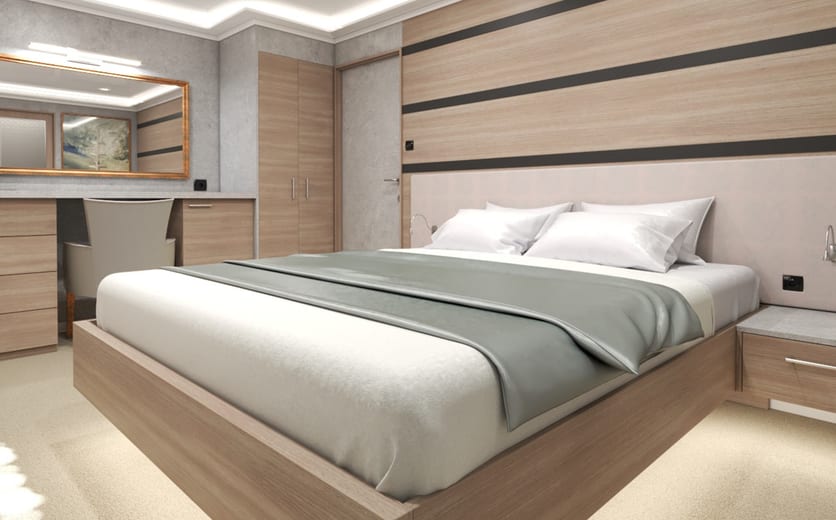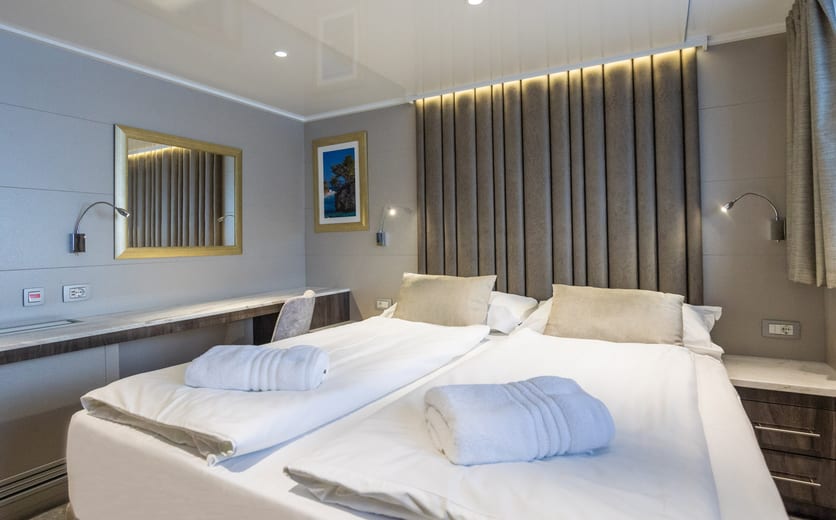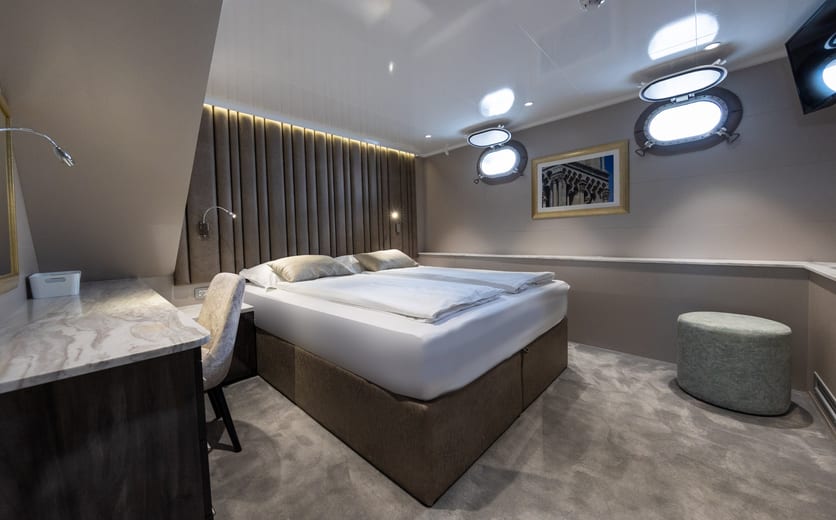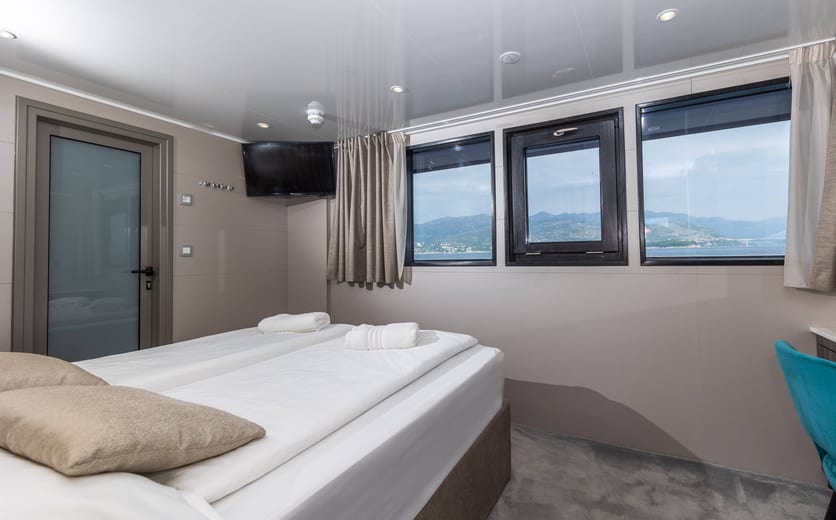




























































28 Apr - 11 May 2026
Return flights from the UK
13 Nights onboard MV Lady Eleganza
Overseas Transfers
Full Board Drinks (with meals)*
Gratuities*
Shore Excursions*
Entertainment*
Not Available
from
£7,995
per person
Not Available
from
£7,995
per person
Our experts are here to help
Call us today on 0203 930 4640 or enquire online.





*Select voyages. T's and C's apply
Day 1
Fly from the UK and arrive in Zagreb this afternoon. Be transferred to your floating home for the next 13 nights, the elegant MV Lady Eleganza docked in Rovinj. Designed and built in Croatia for cruising the Adriatic Coast, it is perfect for nestling into the region's small harbours and sheltered coves.
Day 2
Explore Rovinj, a gem on Croatia's Istrian peninsula. The picturesque Old Town stands on a headland, where quaint houses are nestled amid the towering Church of St. Euphemia. In the afternoon, sail to Pula. Discover the remarkably preserved Pula Arena in the heart of the city, reminiscent of Rome's Colosseum. Built in the first century AD, it once housed up to 23,000 spectators for gladiatorial battles. Pula Arena is the only remaining Roman amphitheatre in existence to have all four walls entirely preserved.
Today an industrial port town and Istria's chief administrative center (pop. 58,000), as well as a major tourist destination, Pula became a Roman colony in the 1st century BC. This came about a century after the decisive defeat by the Romans, in 177 BC, of the nearby Histrian stronghold of Nesactium, prompting the Histrian king Epulon to plunge a sword into his chest lest he fall into the hands of the victors, who indeed conquered all of Istria. Remains from Pula's ancient past have survived up to the present day: as you drive in on the coastal route toward its choice setting on a bay near the southern tip of the Istrian peninsula, the monumental Roman amphitheater blocks out the sky on your left. Under Venetian rule (1331–1797), Pula was architecturally neglected, even substantially dismantled. Many structures from the Roman era were pulled down, and stones and columns were carted off across the sea to Italy to be used for new buildings there. Pula's second great period of development took place in the late 19th century, under the Habsburgs, when it served as the chief base for the Imperial Austro-Hungarian Navy. Today it's as much working city as tourist town, where Roman ruins and Austro-Hungarian architecture serve as backdrop for the bustle of everyday life amid a bit of communist-era soot and socialist realism, too. James Joyce lived here for a short time, in 1904–05, before fleeing what he dismissed as a cultural backwater for Trieste. What's more, there are some outstanding restaurants and a number of pleasant family-run hotels, not to mention the nearby resort area of Verudela, where seaside tourism thrives in all its soothing, sunny sameness.
Day 3
Depart Pula this morning and stop for a swim at Unije before continuing to the island of Lošinj. Home to breathtaking bays and rich vegetation, the island's fresh sea air is infused with the soothing scents of lavender, sage and rosemary. Dock in the main town, Mali Lošinj, characterised by its large natural harbour and the elegant pastel houses that line the waterfront.
Today an industrial port town and Istria's chief administrative center (pop. 58,000), as well as a major tourist destination, Pula became a Roman colony in the 1st century BC. This came about a century after the decisive defeat by the Romans, in 177 BC, of the nearby Histrian stronghold of Nesactium, prompting the Histrian king Epulon to plunge a sword into his chest lest he fall into the hands of the victors, who indeed conquered all of Istria. Remains from Pula's ancient past have survived up to the present day: as you drive in on the coastal route toward its choice setting on a bay near the southern tip of the Istrian peninsula, the monumental Roman amphitheater blocks out the sky on your left. Under Venetian rule (1331–1797), Pula was architecturally neglected, even substantially dismantled. Many structures from the Roman era were pulled down, and stones and columns were carted off across the sea to Italy to be used for new buildings there. Pula's second great period of development took place in the late 19th century, under the Habsburgs, when it served as the chief base for the Imperial Austro-Hungarian Navy. Today it's as much working city as tourist town, where Roman ruins and Austro-Hungarian architecture serve as backdrop for the bustle of everyday life amid a bit of communist-era soot and socialist realism, too. James Joyce lived here for a short time, in 1904–05, before fleeing what he dismissed as a cultural backwater for Trieste. What's more, there are some outstanding restaurants and a number of pleasant family-run hotels, not to mention the nearby resort area of Verudela, where seaside tourism thrives in all its soothing, sunny sameness.
Day 4
This morning, sail to lively Zadar, located on a small peninsula on the Dalmatian Coast. Zadar historically rivalled Venice in importance, and today retains an impressive collection of Roman ruins that seamlessly blend with the new.
Dalmatia's capital for more than 1,000 years, Zadar is all too often passed over by travelers on their way to Split or Dubrovnik. What they miss out on is a city of more than 73,000 that is remarkably lovely and lively despite—and, in some measure, because of—its tumultuous history. The Old Town, separated from the rest of the city on a peninsula some 4 km (2½ miles) long and just 1,640 feet wide, is bustling and beautiful: the marble pedestrian streets are replete with Roman ruins, medieval churches, palaces, museums, archives, and libraries. Parts of the new town are comparatively dreary, a testament to what a world war followed by decades of communism, not to mention a civil war, can do to the architecture of a city that is 3,000 years old. A settlement had already existed on the site of the present-day city for some 2,000 years when Rome finally conquered Zadar in the 1st century BC; the foundations of the forum can be seen today. Before the Romans came the Liburnians had made it a key center for trade with the Greeks and Romans for 800 years. In the 3rd century BC the Romans began to seriously pester the Liburnians, but required two centuries to bring the area under their control. During the Byzantine era, Zadar became the capital of Dalmatia, and this period saw the construction of its most famous church, the 9th-century St. Donat's Basilica. It remained the region's foremost city through the ensuing centuries. The city then experienced successive onslaughts and occupations—both long and short—by the Osogoths, the Croatian-Hungarian kings, the Venetians, the Turks, the Habsburgs, the French, the Habsburgs again, and finally the Italians before becoming part of Yugoslavia and, in 1991, the independent republic of Croatia. Zadar was for centuries an Italian-speaking city, and Italian is still spoken widely, especially by older people. Indeed, it was ceded to Italy in 1921 under the Treaty of Rapallo (and reverted to its Italian name of Zara). Its occupation by the Germans from 1943 led to intense bombing by the Allies during World War II, which left most of the city in ruins. Zadar became part of Tito's Yugoslavia in 1947, prompting many Italian residents to leave. Zadar's most recent ravages occurred during a three-month siege by Serb forces and months more of bombardment during the Croatian-Serbian war between 1991 and 1995. But you'd be hard-pressed to find outward signs of this today in what is a city to behold. There are helpful interpretive signs in English all around the Old Town, so you certainly won't feel lost when trying to make sense of the wide variety of architectural sites you might otherwise pass by with only a cursory look.
Day 5
This morning, set sail for Šibenik. Upon arrival, you will visit spectacular Krka National Park. Spend the afternoon strolling along boardwalks to view the breathtaking waterfalls. The most memorable is Skradinski Buk, which is made up of scores of separate cascades.
Day 6
This morning, enjoy free time to explore Šibenik. Then, enjoy a Signature Experience in Radošić before rejoining your yacht in Split.
Signature Experience — Taste and Traditions of Radošić
On arrival in Radošić, sample some of the local brandy and home-made doughnuts, then take a tour of the family estate, including restored stone houses and a small museum. Afterwards, enjoy a traditional dinner, then watch on as the locals perform songs that have been passed down through generations since the 18th century.
Split's ancient core is so spectacular and unusual that a visit is more than worth your time. The heart of the city lies within the walls of Roman emperor Diocletian's retirement palace, which was built in the 3rd century AD. Diocletian, born in the nearby Roman settlement of Salona in AD 245, achieved a brilliant career as a soldier and became emperor at the age of 40. In 295 he ordered this vast palace to be built in his native Dalmatia, and when it was completed he stepped down from the throne and retired to his beloved homeland. Upon his death, he was laid to rest in an octagonal mausoleum, around which Split's magnificent cathedral was built.In 615, when Salona was sacked by barbarian tribes, those fortunate enough to escape found refuge within the stout palace walls and divided up the vast imperial apartments into more modest living quarters. Thus, the palace developed into an urban center, and by the 11th century the settlement had expanded beyond the ancient walls.Under the rule of Venice (1420–1797), Split—as a gateway to the Balkan interior—became one of the Adriatic's main trading ports, and the city's splendid Renaissance palaces bear witness to the affluence of those times. When the Habsburgs took control during the 19th century, an overland connection to Central Europe was established by the construction of the Split–Zagreb–Vienna railway line.After World War II, the Tito years saw a period of rapid urban expansion: industrialization accelerated and the suburbs extended to accommodate high-rise apartment blocks. Today the historic center of Split is included on UNESCO's list of World Heritage Sites.
Day 7
Take a guided walking tour of historic Split, discovering the city's beautiful Roman-era landmarks. Later, board a small boat for an excursion along the emerald-green Cetina River. You'll head to picturesque Radmanove Mlinice (Radman's Mills), established in 1772 to grind cereal for the people of Omis. Later, rejoin your yacht in Markarska.
Day 8
This morning, continue to the breathtaking island of Brač. Head to the coastal town of Bol, where a memorable Signature Experience awaits. Later, your ship will sail to Opuzen, where you will have dinner in a local restaurant.
Signature Experience – Stina Winery
Immerse yourself in the charm of Dalmatia with a visit to Stina Winery. The award-winning winery carries a legacy that dates back to the early 1900s, when the First Dalmatian Wine Cooperative was established in Bol. Indulge your senses as expert staff guide you through a curated tasting of white and red wine varieties grown in the Dalmatia region. The wine tasting will be perfectly paired with local delicacies, including olives, artisanal cheeses and cured ham.
Day 9
This morning, travel by coach over the border to fascinating Mostar in Bosnia and Herzegovina. Its most famous landmark is the beautiful World Heritage-listed Stari Most (Old Bridge), which arches high above the Neretva River. It was rebuilt to its original medieval specifications, after being damaged in the 1990s Balkan conflict. You'll visit the bridge and more on a walking tour. Enjoy lunch before returning to your yacht and setting sail for Korčula.
Off the coast of Croatia in the southern Adriatic Sea lie some thousand islands and the largest of them, Korçula, is considered the most beautiful. With an average of 3,000 hours of sunshine per annum, which guarantees a wide assortment of Mediterranean vegetation, it is not difficult to understand why seasoned travelers compare Korçula to a latter-day Eden. Separated from the mainland by a channel of only one mile, Korçula's main town, named the same as the island, ranks among the best preserved medieval towns in the Mediterranean. It is the island's main tourist, economic and cultural center. Thanks to its strategic location along the sea trade routes, Korçula has always attracted travelers and settlers. Korcula was founded by Greek colonists, who were followed by Illyrians, Romans and finally the Croats. The Korçula Statute of 1214 is one of the oldest legal documents to have been adopted in this part of Europe. The same century saw the birth of the famous world traveler, Marco Polo. The house said to be his birthplace can be seen in town. Korçulans have always been known as keen seafarers, excellent shipbuilders, stonemasons and artists. From their many voyages, sailors brought back new ideas, which eventually mixed with local customs. To this day, Korçula has maintained the tradition of performing knightly games such as the chivalrous Moreska dance, which has been in existence for more than 400 years. Visitors to Korçula enjoy its stunning location, natural beauty and medieval ambiance. And if that's not enough, the town offers numerous attractions that are within walking distance from the pier, including the City Museum and the Bishop's Treasury.
Day 10
Enjoy a special Signature Experience this morning, then sail for the Elaphiti Islands off the Croatian coast. Stop for a swim before continuing on to Šipan, where your yacht will dock overnight.
Signature Experience – Traditional Moreška Performance
Witness an exclusive Moreška performance, a traditional sword dance and drama dating back centuries. A captivating tale of love and conflict, the dance depicts a battle between two kings and their armies over a captured princess.
Lush, relaxed island resort with beaches, water sports, wine-making, bike rentals & hotels.
Day 11
Enjoy a guided tour of Šipan. Later, spend the afternoon cruising to the picturesque harbour town of Cavtat, where your ship will dock overnight.
Lush, relaxed island resort with beaches, water sports, wine-making, bike rentals & hotels.
Day 12
This morning, travel by coach to Herceg Novi in Montenegro. From here, board local boats and cruise into the striking Bay of Kotor. This picturesque natural harbour is framed by sheer cliffs that hug the walled town of Kotor. Enjoy a walking tour of Kotor’s Old Town before spending time at leisure. Later, return to your ship in Cavtat.
Backed by imposing mountains, tiny Kotor lies hidden from the open sea, tucked into the deepest channel of the Bokor Kotorska (Kotor Bay), which is Europe's most southerly fjord. To many, this town is more charming than its sister UNESCO World Heritage Site, Dubrovnik, retaining more authenticity, but with fewer tourists and spared the war damage and subsequent rebuilding which has given Dubrovnik something of a Disney feel.Kotor's medieval Stari Grad (Old Town) is enclosed within well-preserved defensive walls built between the 9th and 18th centuries and is presided over by a proud hilltop fortress. Within the walls, a labyrinth of winding cobbled streets leads through a series of splendid paved piazzas, rimmed by centuries-old stone buildings. The squares are now haunted by strains from buskers but although many now house trendy cafés and chic boutiques, directions are still given medieval-style by reference to the town’s landmark churches.In the Middle Ages, as Serbia's chief port, Kotor was an important economic and cultural center with its own highly regarded schools of stonemasonry and iconography. From 1391 to 1420 it was an independent city-republic and later, it spent periods under Venetian, Austrian, and French rule, though it was undoubtedly the Venetians who left the strongest impression on the city's architecture. Since the breakup of Yugoslavia, some 70% of the stone buildings in the romantic Old Town have been snapped up by foreigners, mostly Brits and Russians. Porto Montenegro, a new marina designed to accommodate some of the world’s largest super yachts, opened in nearby Tivat in 2011, and along the bay are other charming seaside villages, all with better views of the bay than the vista from Kotor itself where the waterside is congested with cruise ships and yachts. Try sleepy Muo or the settlement of Prčanj in one direction around the bay, or Perast and the Roman mosaics of Risan in the other direction.
Day 13
Soak up the serenity as you sail to Dubrovnik this morning. On arrival, explore the World Heritage-listed Old Town, a fairytale world of palaces, monasteries and churches enclosed within the spectacular medieval city walls.
Nothing can prepare you for your first sight of Dubrovnik. Lying 216 km (135 miles) southeast of Split and commanding a jaw-dropping coastal location, it is one of the world's most beautiful fortified cities. Its massive stone ramparts and fortress towers curve around a tiny harbor, enclosing graduated ridges of sun-bleached orange-tiled roofs, copper domes, and elegant bell towers. Your imagination will run wild picturing what it looked like seven centuries ago when the walls were built, without any suburbs or highways around it, just this magnificent stone city rising out of the sea.In the 7th century AD, residents of the Roman city Epidaurum (now Cavtat) fled the Avars and Slavs of the north and founded a new settlement on a small rocky island, which they named Laus, and later Ragusa. On the mainland hillside opposite the island, the Slav settlement called Dubrovnik grew up. In the 12th century the narrow channel separating the two settlements was filled in (now the main street through the Old Town, called Stradun), and Ragusa and Dubrovnik became one. The city was surrounded by defensive walls during the 13th century, and these were reinforced with towers and bastions in the late 15th century.From 1358 to 1808 the city thrived as a powerful and remarkably sophisticated independent republic, reaching its golden age during the 16th century. In 1667 many of its splendid Gothic and Renaissance buildings were destroyed by an earthquake. The defensive walls survived the disaster, and the city was rebuilt in baroque style.Dubrovnik lost its independence to Napoléon in 1808, and in 1815 passed to Austria-Hungary. During the 20th century, as part of Yugoslavia, the city became a popular tourist destination, and in 1979 it was listed as a UNESCO World Heritage Site. During the war for independence, it came under heavy siege. Thanks to careful restoration, few traces of damage remain; however, there are maps inside the Pile and Ploče Gates illustrating the points around the city where damage was done. It’s only when you experience Dubrovnik yourself that you can understand what a treasure the world nearly lost
Day 14
After breakfast, it is time to bid a fond farewell to the MV Lady Eleganza. You will be transferred to the airport for your return flight to the UK.
Nothing can prepare you for your first sight of Dubrovnik. Lying 216 km (135 miles) southeast of Split and commanding a jaw-dropping coastal location, it is one of the world's most beautiful fortified cities. Its massive stone ramparts and fortress towers curve around a tiny harbor, enclosing graduated ridges of sun-bleached orange-tiled roofs, copper domes, and elegant bell towers. Your imagination will run wild picturing what it looked like seven centuries ago when the walls were built, without any suburbs or highways around it, just this magnificent stone city rising out of the sea.In the 7th century AD, residents of the Roman city Epidaurum (now Cavtat) fled the Avars and Slavs of the north and founded a new settlement on a small rocky island, which they named Laus, and later Ragusa. On the mainland hillside opposite the island, the Slav settlement called Dubrovnik grew up. In the 12th century the narrow channel separating the two settlements was filled in (now the main street through the Old Town, called Stradun), and Ragusa and Dubrovnik became one. The city was surrounded by defensive walls during the 13th century, and these were reinforced with towers and bastions in the late 15th century.From 1358 to 1808 the city thrived as a powerful and remarkably sophisticated independent republic, reaching its golden age during the 16th century. In 1667 many of its splendid Gothic and Renaissance buildings were destroyed by an earthquake. The defensive walls survived the disaster, and the city was rebuilt in baroque style.Dubrovnik lost its independence to Napoléon in 1808, and in 1815 passed to Austria-Hungary. During the 20th century, as part of Yugoslavia, the city became a popular tourist destination, and in 1979 it was listed as a UNESCO World Heritage Site. During the war for independence, it came under heavy siege. Thanks to careful restoration, few traces of damage remain; however, there are maps inside the Pile and Ploče Gates illustrating the points around the city where damage was done. It’s only when you experience Dubrovnik yourself that you can understand what a treasure the world nearly lost
from £7,995 per person

Cabins have either portholes or large windows.
For solo travellers, there are single porthole cabins available.

Cabin includes:

Cabin includes:

Cabin includes:

Cabin includes:
from £7,995 per person
from £7,995 per person

Cabins have either portholes or large windows.
For solo travellers, there are single porthole cabins available.

Cabin includes:

Cabin includes:

Cabin includes:

Cabin includes:
from £7,995 per person

















